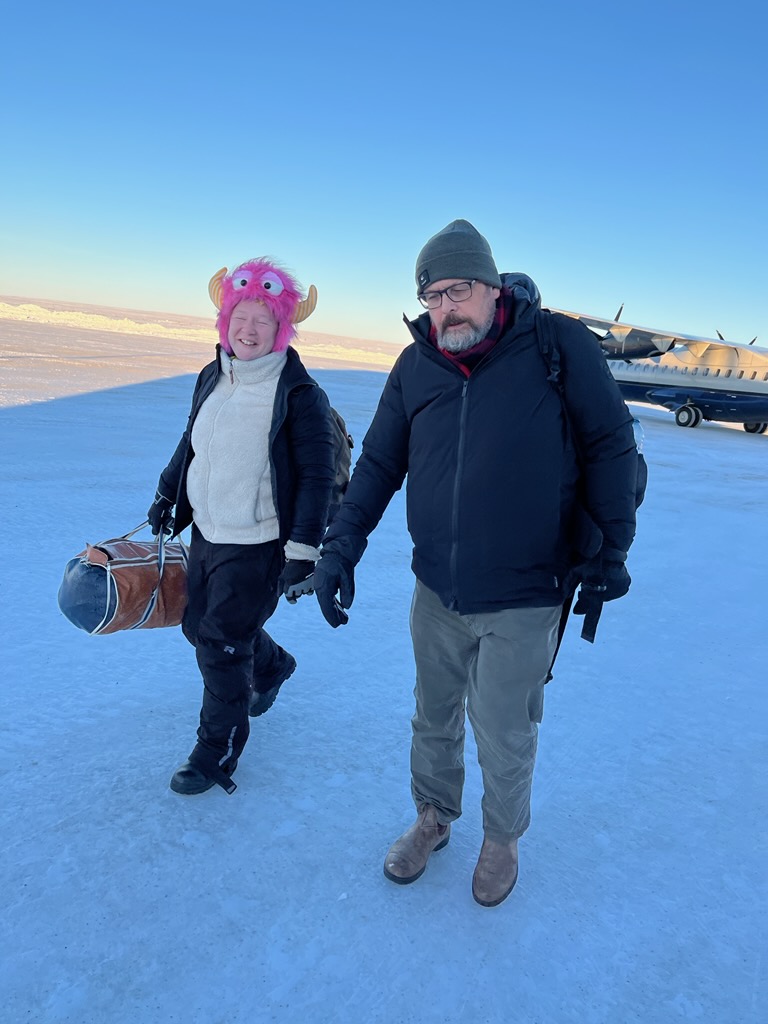Preparation Gjoa Haven Workshop: Difference between revisions
No edit summary |
|||
| Line 60: | Line 60: | ||
Keep going if you want to learn about the scientific presentations instead.</div> | Keep going if you want to learn about the scientific presentations instead.</div> | ||
<span class="pop-up link" data-page-title="Gaps, Openings and Possibilities" data-section-id="0" data-encounter-type="Landmark">[[Gaps, Openings and Possibilities|Landmark: Gaps, Openings and Possibilities]]</span> | <span class="pop-up landmark link" data-page-title="Gaps, Openings and Possibilities" data-section-id="0" data-encounter-type="Landmark">[[Gaps, Openings and Possibilities|Landmark: Gaps, Openings and Possibilities]]</span> | ||
=Scientific Presentations= | =Scientific Presentations= | ||
Revision as of 10:47, 21 January 2025
Now that I had a list of of solid and applicable guidelines to the workshop agenda, it was time to organize the workshop itself.
Seeking and preparing a space that would be fitting, and provide the right conditions to space of exchange and open-ness, we decided on the ... center. A room in which the community sometimes organizes drumdances and other cultural affairs. We also found a caterer, and decided on a menu for each day including the community feast on the first night. Thirdly, we needed to scout an appropriate site to build a Qaggiq: a big communal igloo, especially for gatherings - to be built on the second day of our workshop.
Invitation: Workshop preparations
3 day Workshop Gjoa Haven
After a day of gathering chairs from across the hamlet, boiling water, charging translation headphones, making coffee, and organizing transport to pick up elders, at the evening of the 21 November it was time to start our Gathering.
Attendees from the south who would join for the gathering, including Bettina ...., the director of Genome Canada and Les ...., the .... of Genome Canada had arrived the previous afternoon. Marsha Brannigan, recently retired wildlife biologist for the NWT, who had run the BearWatch project, Kimberley McClintock project manager for BearWatch, and prof. Graham Whitelaw and prof. Stephen Lougheed, PI's of the project also arrived three days prior to the gathering.
Opening: Movie Screening and a Feast
24 community members, including our research partners and interpretor showed up to our opening feast and movie screening. Apart from community members, there were in total five Queens University researchers, one former government biologist and two Genome Canada funders present for the evening. During this first evening we had no online participants calling in. We were present with 32 people.
As discussed in the pre-workshop we took plenty of time for people to arrive and get comfortable. Attendees were greeted by Mx. Science, and some of the younger women who had shown up. We made sure that elders were seated in the comfortable couches and everyone received something to drink.
Once, we felt that people had had enough time to settle in, we opened the gathering with prayers and with some words from the Gjoa Haven HTA vice-chair, James Qitsualik, who had lead the project within the community. We then screened the three community co-created movies: Voices of Thunder, Pihhiq, and the throatsinging film with Kathy and Janet.
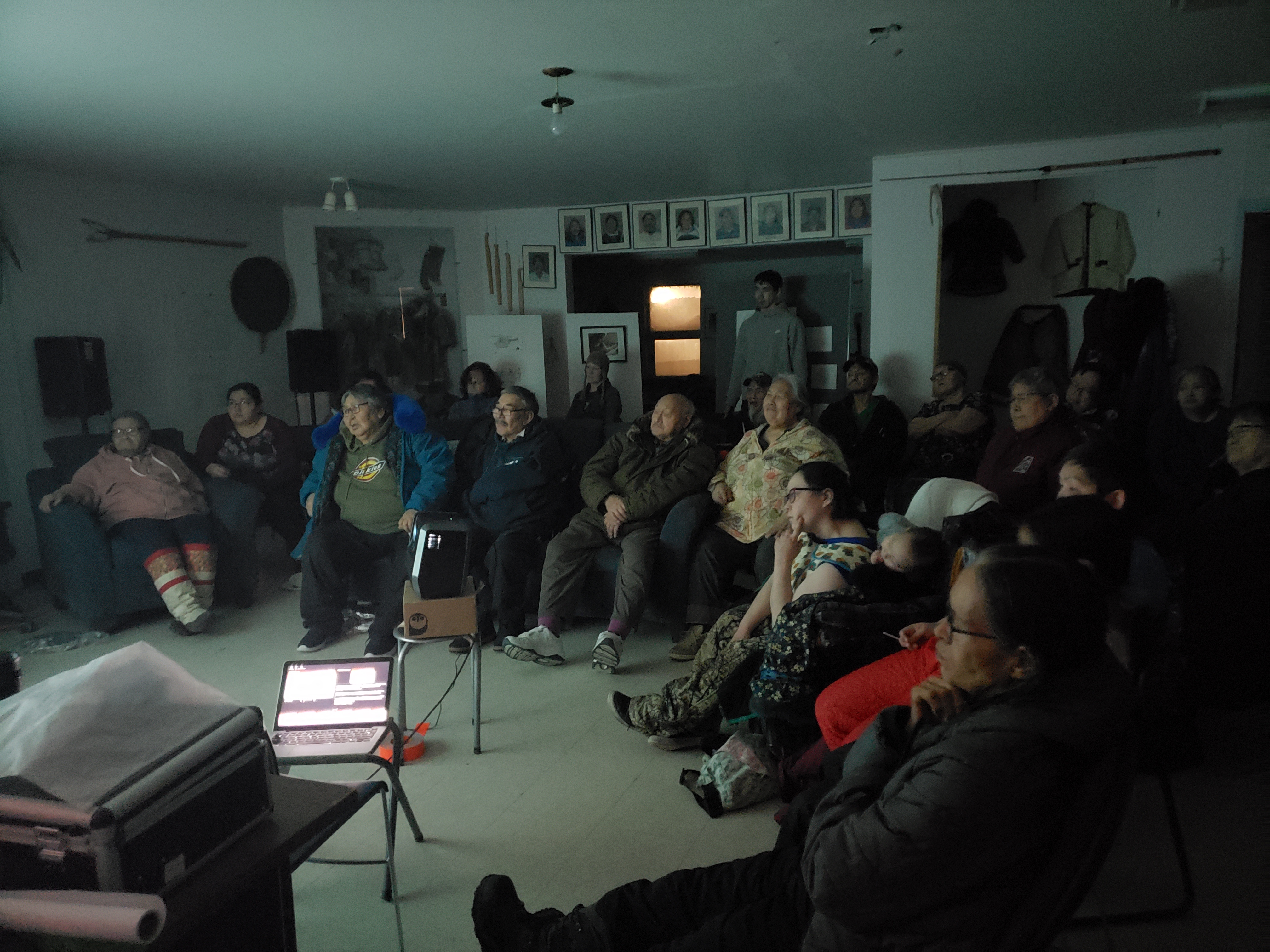
Polar Bear Landscape Presentation
After the feast Marsha Brannigan presented on the governmental context within which the BearWatch project had played out. This presentation was put on the agenda, to sketch a contextual backdrop for the next couple of days. Despite its awkward placement after the feast, Branigan clearly had lots of experience with presenting for community members, and often built in "empty" moments for people to ask questions or comments.
The opening evening ended with an invitation to come back the next days. We explained how the next three-day gathering was also part of the research project, and that people would be asked for their informed consent to be part of this research and to be photographed if they would come back over the next three days. We indicated our starting time, and explained the program for the next day: Science-presentations.
Day 1: Science-Presentations, Opening and Singing
On the first day of our Gathering 20 community members including our community partners and 15 online attendees (of which four remote presenters) turned up, in addition to the five Queen's University researchers, the NWT biologist and the two funders. A total of 43 people.
The previous evening, around the time of closing prayers, news had started to trickle into the room about a young women that had passed away that day due to an accident. People had been visibly upset the evening before, and still were so when they came back the next day. Mary, who was present to conduct the opening and closing prayers during this gathering requested to sing a song instead.
We all got up from our chairs as Mary led us into song. It was an emotional moment of shared grief and many people started crying in the room.
Mx. Science Hosting
Originally, this would have been the moment that the Gathering would be opened with some welcoming words by PI Peter van Coeverden de Groot, and HTA vice-chair James Qitsualik. However it seemed clear that there was a lot of pain in the room, and that somewhat of a transition was required before "business as usual could be picked up.
As the designated host of the gathering, I stepped up to express my sympathies and reiterated that this gathering was meant to provide a space where we can meet each other as whole people, with emotions and identities beyond our titles and official functions. I read out the general guiding principles "to meet in a good way" that were suggested during the pre-workshop, and then pointed them out in the room. In this way I had meant to set an intention in the room, in a similar way to how I had learnt prayers usually function. After that, I passed the word to Peter, who initiated an introduction round across the room in which we shared something about ourselves, and why we were in the room, and what our hopes for gathering week were.
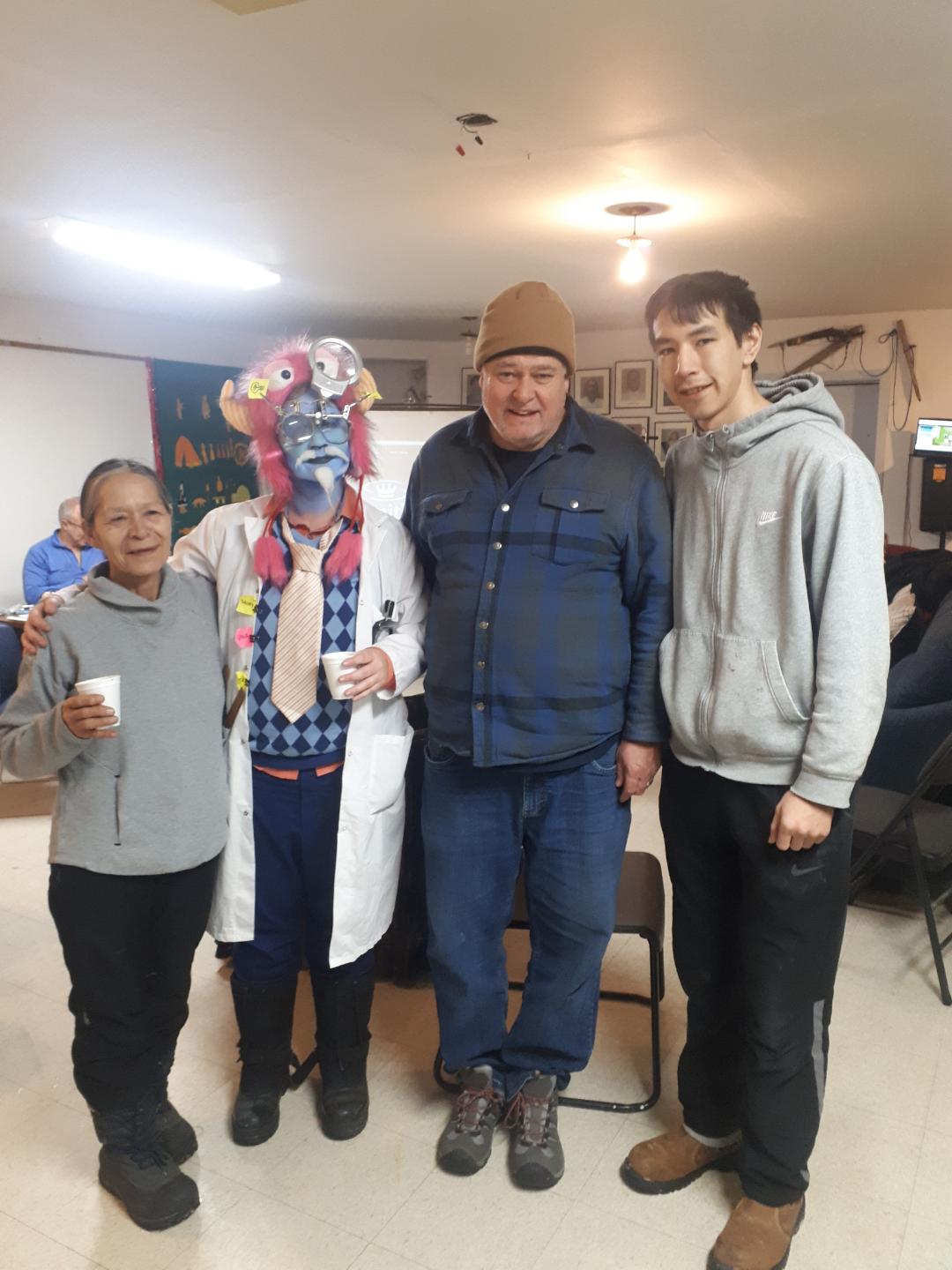
This introduction included all southern researchers, and community-members who had been working to set-up the space and support the gathering in various ways. This included for example Aida Porter, who had agreed to present on the first and third day to take plenary notes - a suggestion that had emerged from the pre-workshop, as to keep track and collect questions that could be answered after the gathering, in case it wasn't possible to answer community questions in the room.
Landmark: Gaps, Openings and Possibilities
Scientific Presentations
The first day of the Gathering consisted of polar bear science presentations. Most of those were presented remotely through the zoom-presentation link.
Based on research I had conducted for a Research Assistance-ship on research communication, earlier in my PhD, I had asked presenters through a 'instruction email" to use the "message box" (COMPASS, year) as a template to format their presentations with. The report I had written for this RA-ship included the following segment on the use of this message-box.
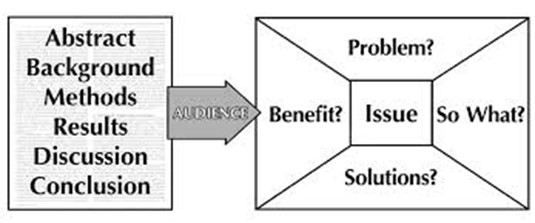
"As important as knowing your personal goals as a scientist to why you want to communicate your science is, it is also essential to understand your audience’s ‘why’. The audience equivalent of ‘why?’, as well as contextualizing it more directly into science communication practice, is COMPASS’s question ‘so what?’. ‘So what?’ makes it possible to formulate your ‘take home message’ and adapt it to your audience. By answering the ‘so what’ question of the message box, with your audience in mind you can link the research issue, the benefit of your research, the problem and the solution to your research problem to goals relevant to your audience (Baron, 2010)? Preparing such a message box, in other words can form a useful tool to ‘distil your knowledge in a way that resonates with your audience’ (Green, 2018)."
Exhibition Danny Aaluk
During the gathering I had installed an ongoing exhibition of Danny's work.
This exhibition was physically accessible, within the Gathering space, as well as digitally accessible through the Kumospace.
Art Gallery Danny Aaluk by gingertheworld
Day 2: Building Igloo
The second day of the workshop took a completely different shape. Eight community members (three elders, four youth and the interpretor) joined with the eight participants from the south. We were to build an igloo together. Originally, we planned to build a qaggiq, a special kind of structure that is specifically meant to come together and renew relationships. Due to a lack of the right kind of snow and limited time, we pivoted to the building of an igloo instead.
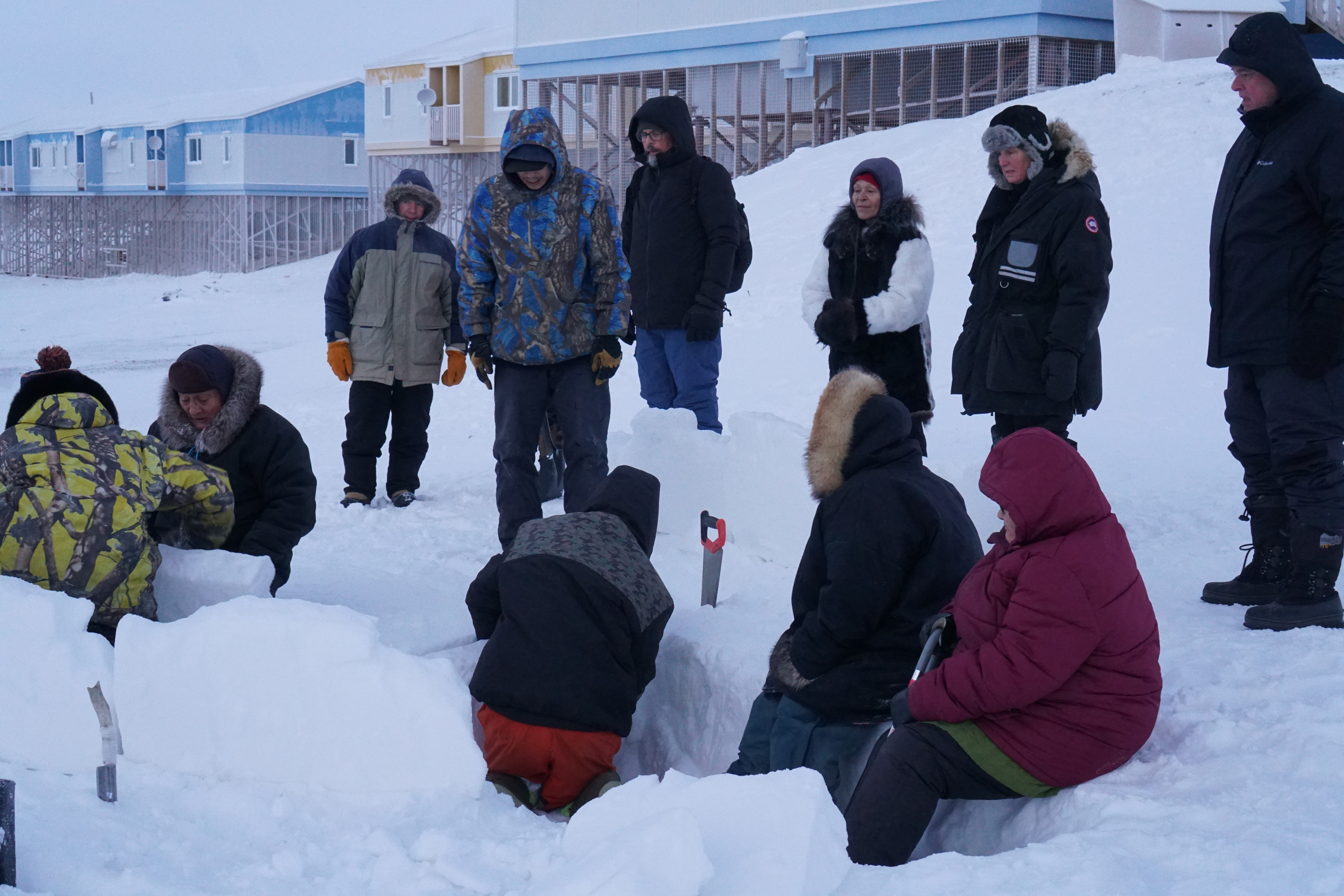
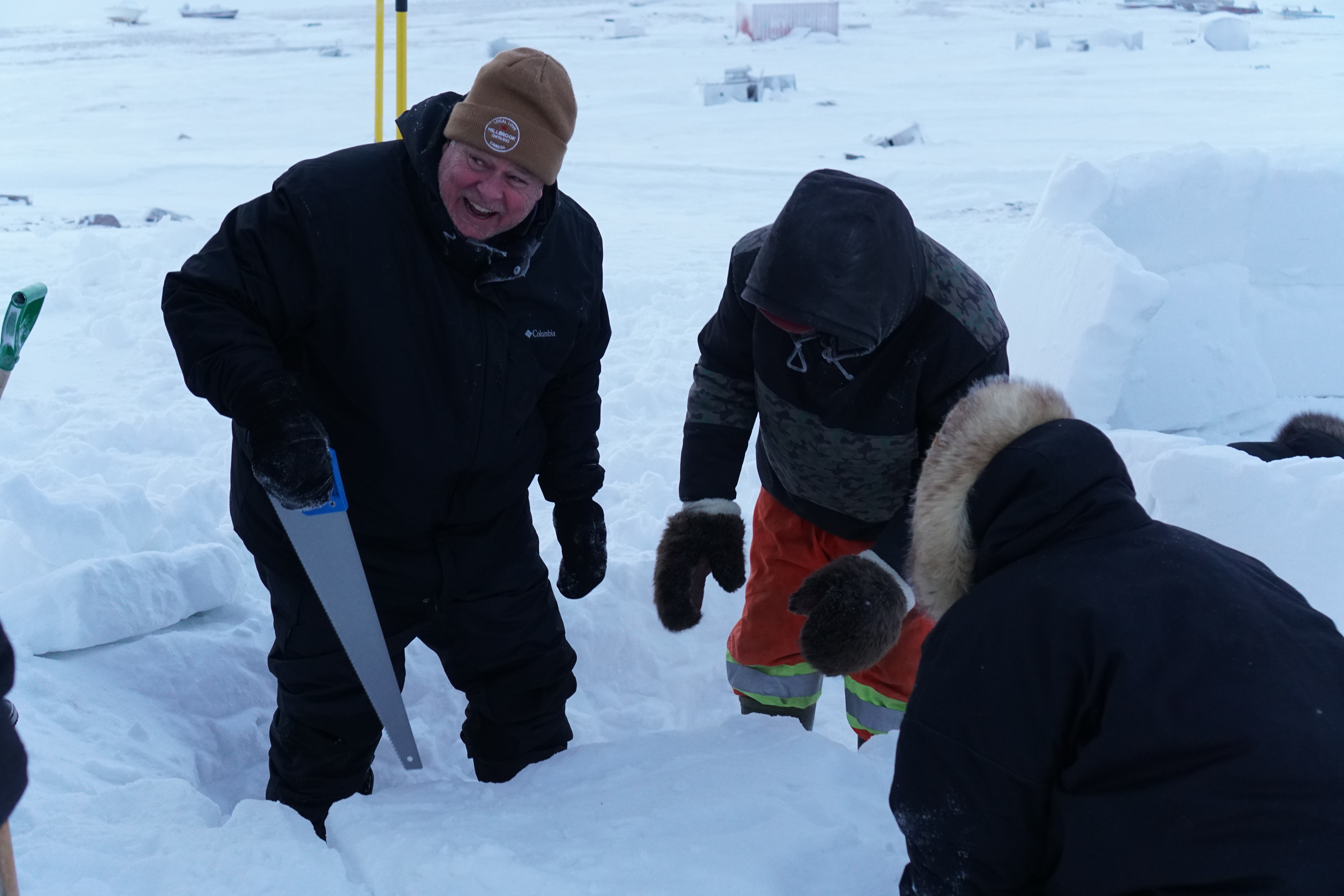
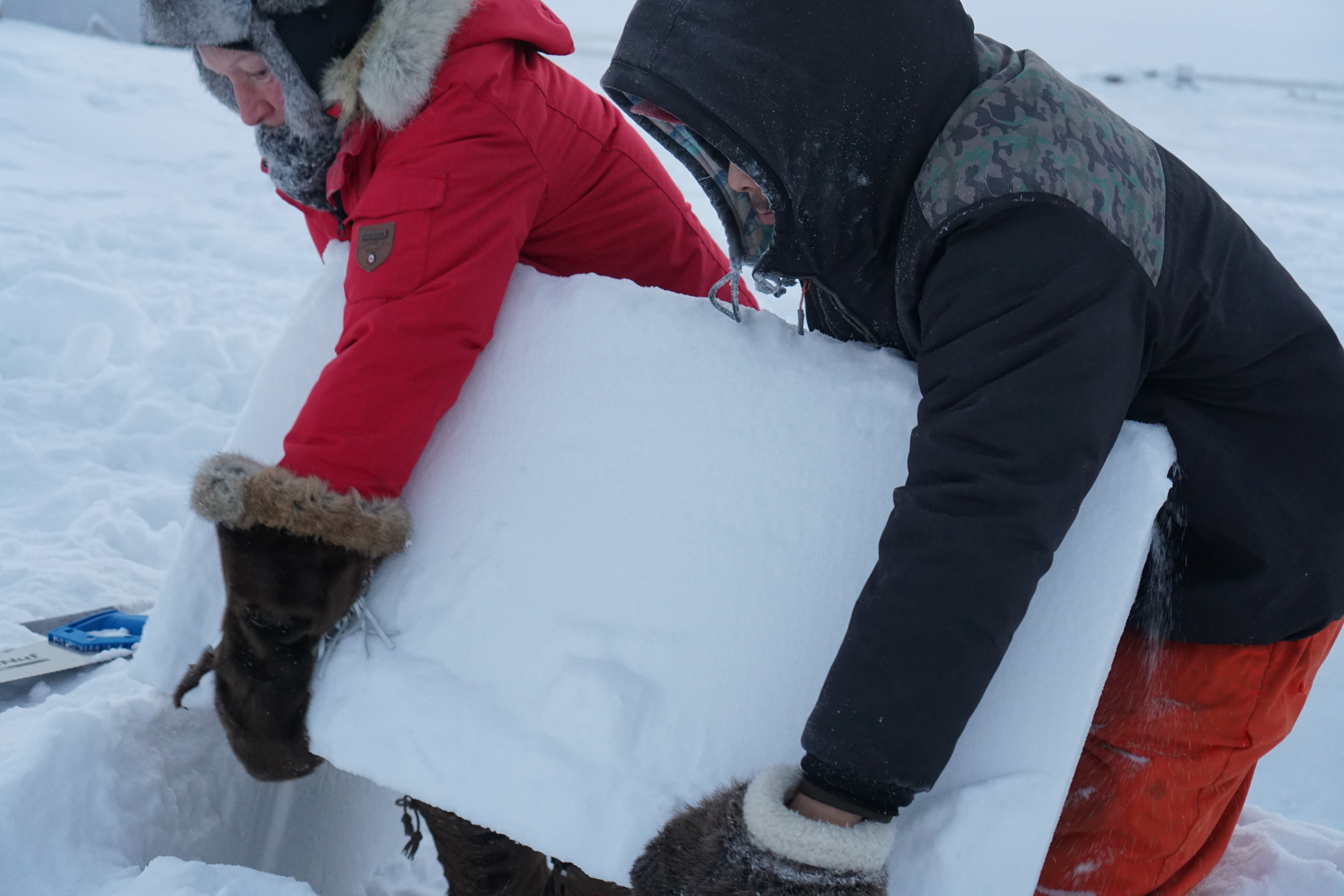
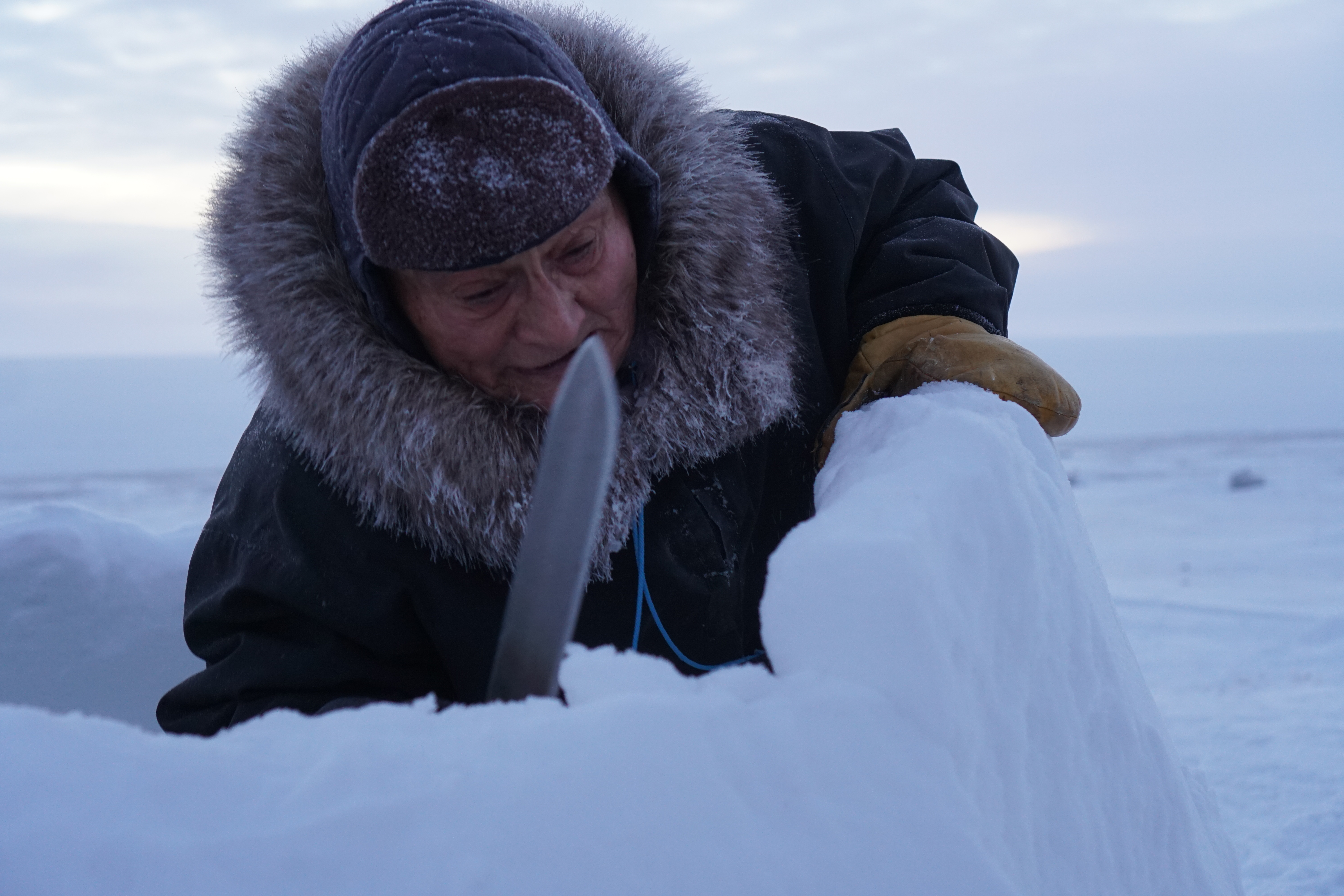
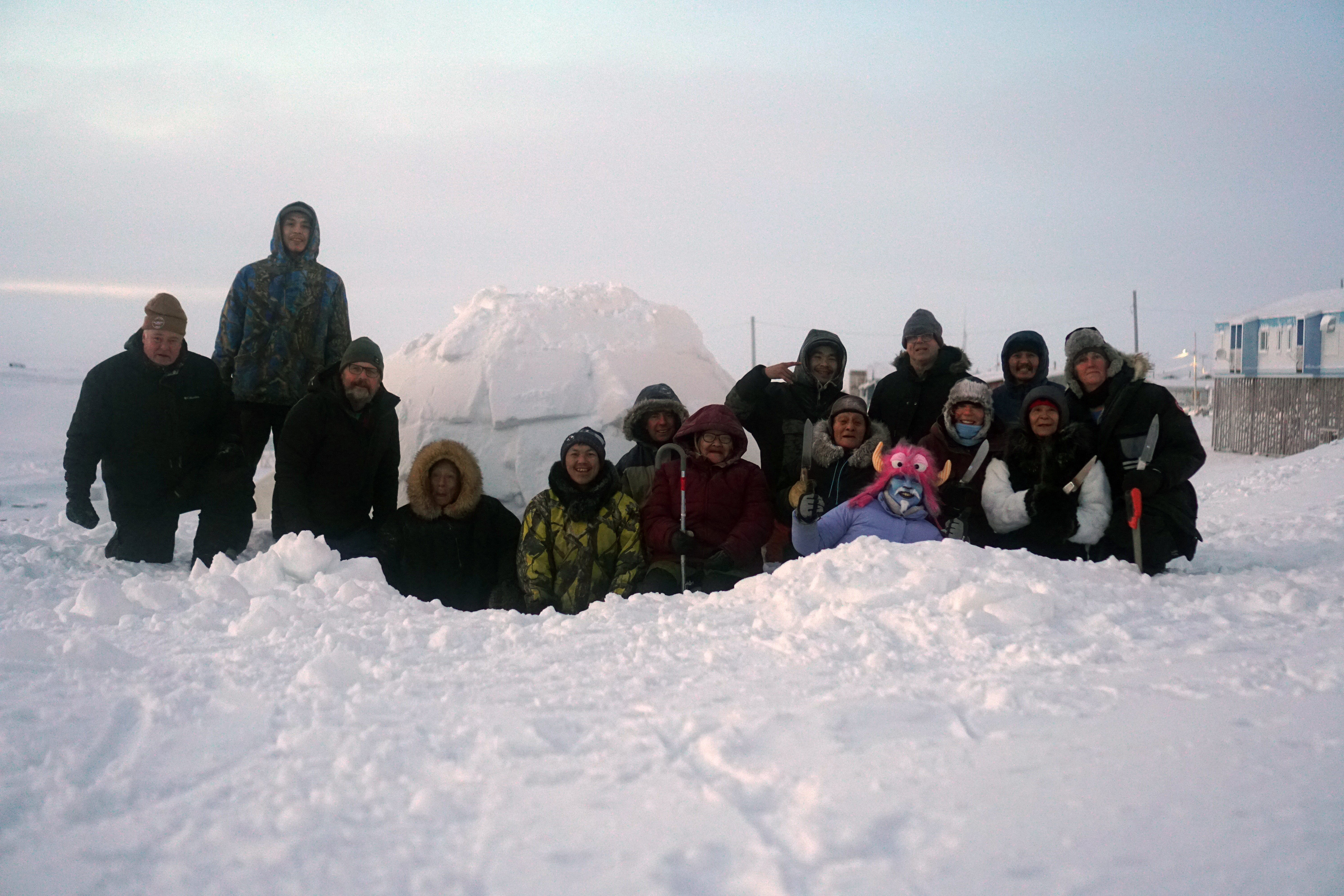
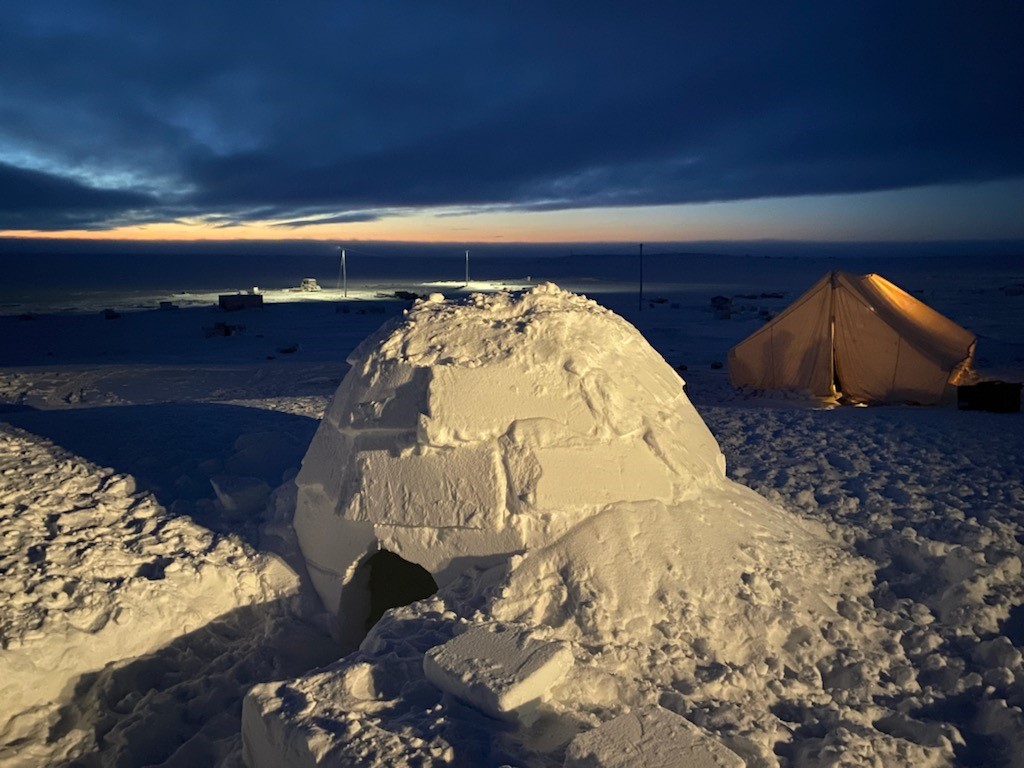
This day was designed to facilitate intra-generational and cultural knowledge exchange through partaking in a shared practice. A highschool class and 2 teachers also passed by in the morning, as I had posted the activity on facebook and had invited community members to come by and if possible help. My hope was for such an activity to shift conversations on knowledge conciliation away from data towards that of 'encountering each other". The terms of engagement on this second day, were as such very different than the first day. Community elders took the lead. And for the first hour, southern participants just observed. As David and Jimmy discussed how to make the cuts and the outlines of where the igloo was to be built, they instructed the four young men that had joined to assist and learn, what to do. After a while, as agreed, two of the young men started to teach the southern researchers how to cut a block.
David had scouted a practice patch where we could learn how to cut blocks. It became clear that even though the elders had expected our blocks to all be "rejects", our cuts were clean enough for the blocks to be all used in the igloo. Being able to build this structure together was considered by some southern participants as the highlight of the trip. Prof. Whitelaw described seeing his block go into the structure as a very satisfying moment.
Evaluation
After finishing the structure and taking a group picture, we retreated into a warm tent for Bannock and "klik". In the tent we had a sharing circle to reflect on how this experience had been for everyone. As we went around the circle, everyone shared.

One of the most striking moments for me were when Mary described the activity as "healing" and as a renewal of the relationship between southern researchers and the community. The second was when Percy Ikualaq mentioned that it was a very special experience for him to build this igloo under guidance of David. It was great to spend time with him and receiving all the instructions and explanations. This is also where Tuppittia value was once again added in multiple ways than one. Not only did she interpret between Inuktitut and English, she also facilitated communication between generations in Inuktitut. She furthermore helped build the igloo and brought in lots of joyful energy.
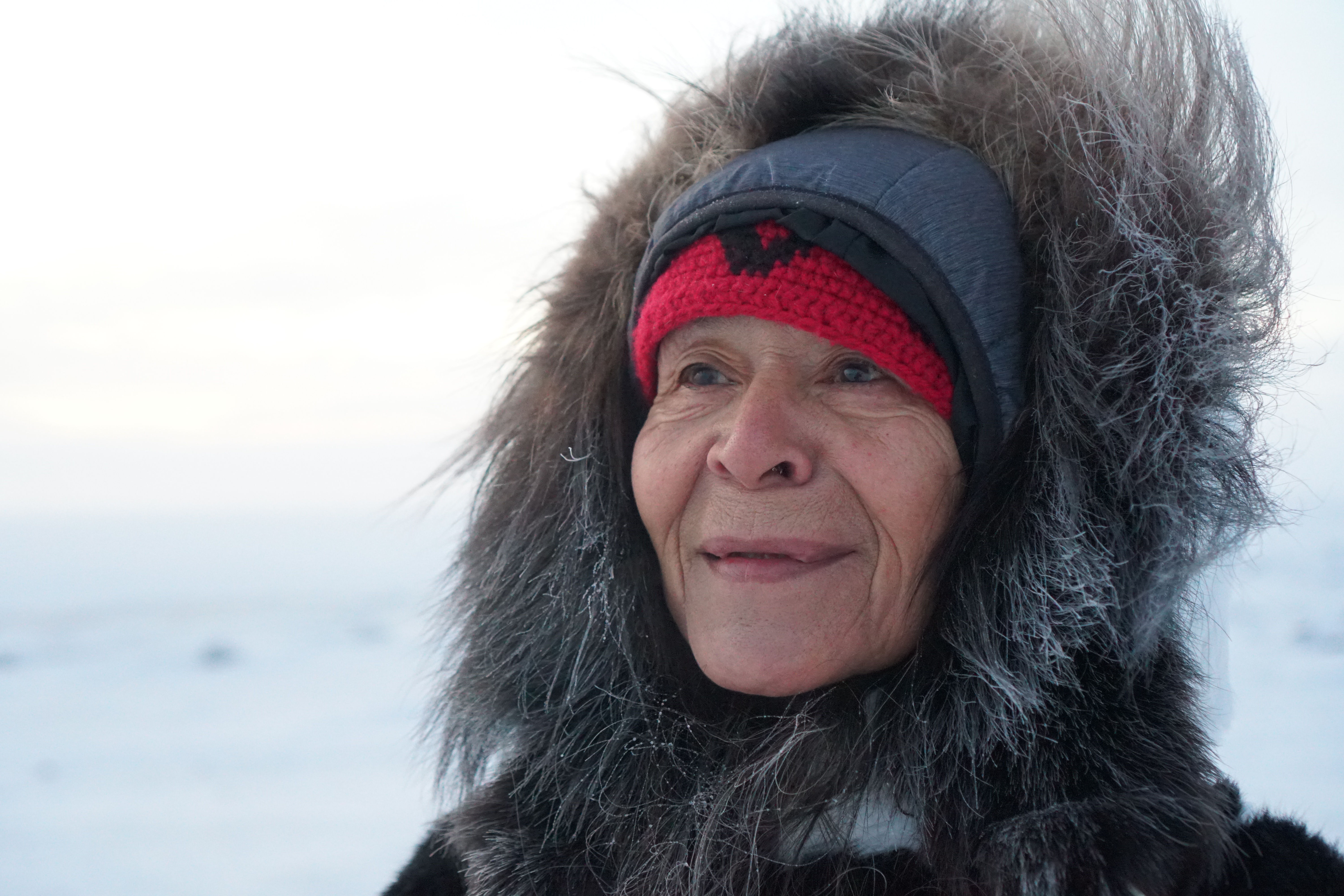
Although this day was much shorter, it was satisfying and felt very rewarding to have built something together.
Day 3: Living With Polar Bears
Day three of the gathering consisted of a conversation on the future of polar bear monitoring and management. Bringing together insight from science, the management landscape and Inuit insights and expertise through a panel that represented a diversity in age and expertise, we discussed how we would like to implement the tools that were developed through the BearWatch project in future projects.
This day the gathering consisted of 8 community members (including elders, wildlife officer, HTA chairman and interpreter), 6 online attendees (of which 1 presenter) and the eight southern researchers. A total 16 people. At one point the highschool class that had passed by the building of the igloo, passed by again for an hour.
The idea of setting up a panel had also come from the pre-workshop. One of the questions I had asked during the pre-workshop was how we could ensure that there would be enough space for different voices to be heard, and in which ways we could make people feel comfortable enough to share. The suggestion was raised to erect a panel consisting of the following people: 2 senior researchers, 2 HTO people, 2 youth, 1 40/50 yr old, 2 elders.
Peter van Coeverden de Groot moderated this third day. As Aida Porter, was unwell on this last day, I took over her role as a note-taker. I did so, by taking graphic notes (on-the-spot visualization).
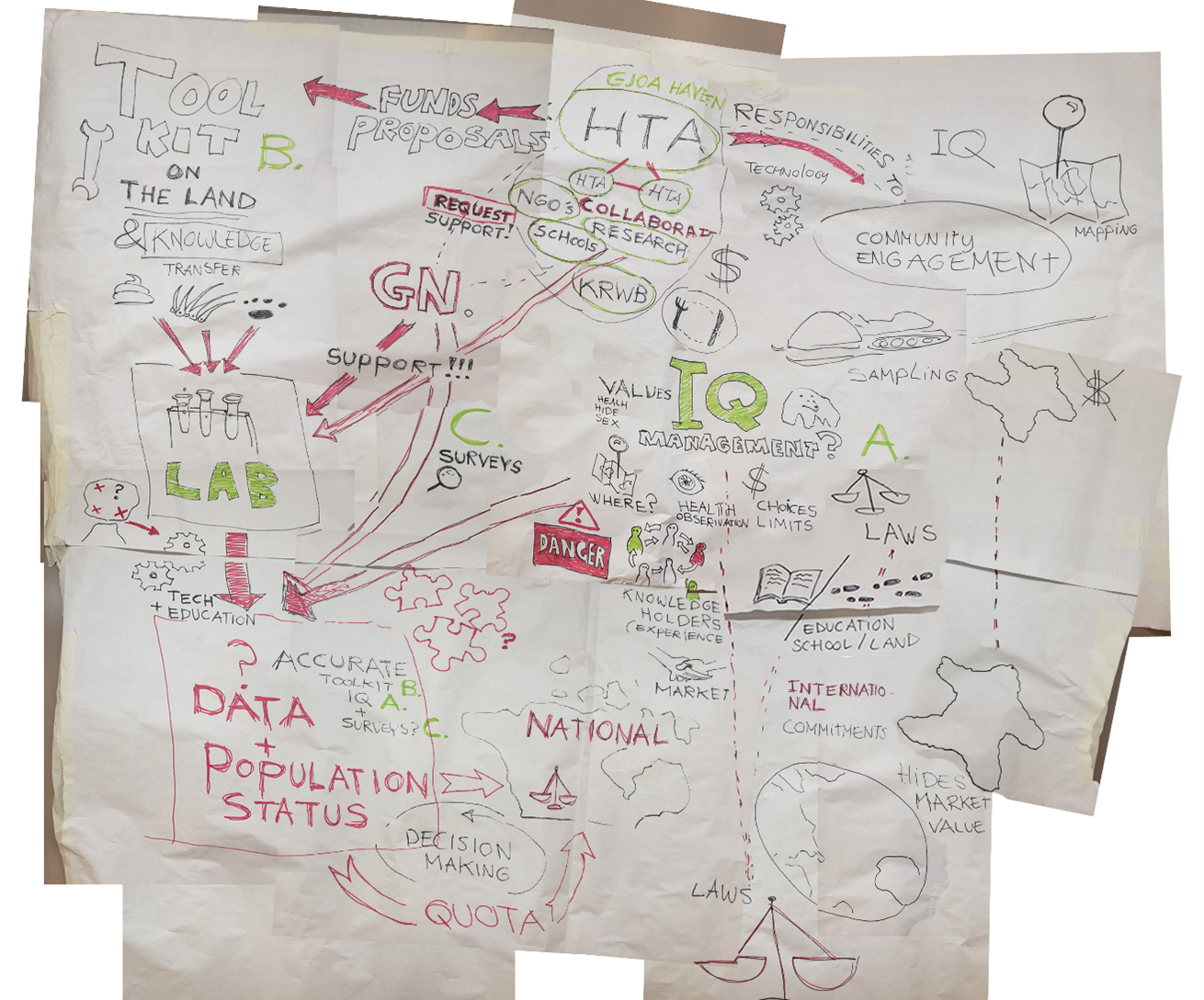
Closing
The morning after the third day we met with a smaller group to de-brief and evaluate the gathering. Present at this evaluation were two elders, the Gjoa Haven HTA vice-chair and our interpretor, as well as the BearWatch funders, PI's, the former government biologist of NWT, and two BearWatch researchers including me. This evaluation was lead my me, and the questions were based on key concepts that had emerged from my auto-ethnographic notes, literature and, most importantly, on the terms of engagement that were drafted during the pre-gathering and that were agreed upon across the workshop organizers prior to our gathering.
Design Consultation Pre-Workshop & Workshop Coral Harbour
This particular cut continues on a different track. The final workshop in Coral Harbour. The research in this community has emerged along completely different timelines and relational dynamics.
